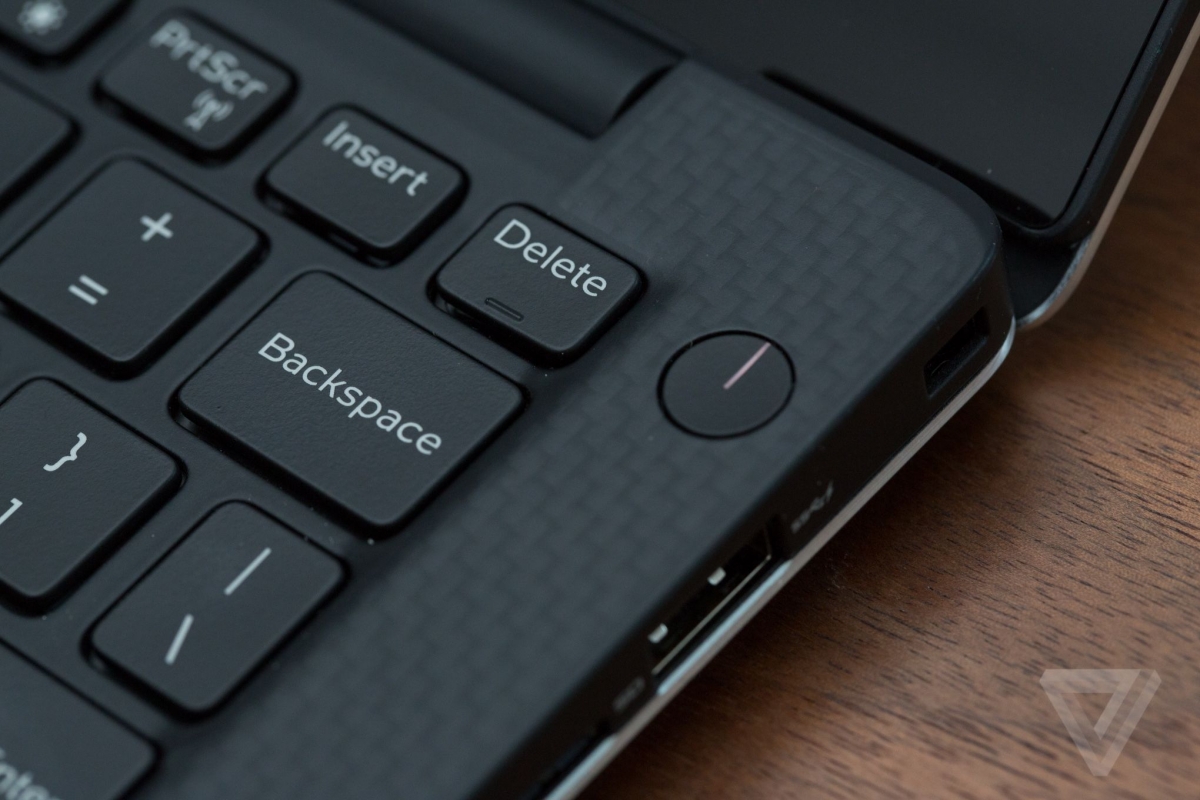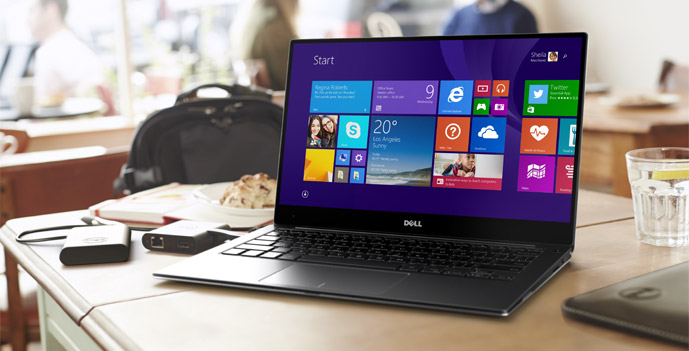The smallest 13-inch laptop on the planet has the world’s first virtually borderless Infinity Edge display — amazing both inside and out.
The best laptop just got even better. With its latest updates, Dell has given the XPS 13, our favorite notebook, a brighter screen, longer battery life, a new USB-C port with Thunderbolt 3 and your choice of Intel's latest 6th-generation Core Series CPUs. Dell also kept all the features we liked on the previous model, including the sexy aluminum and carbon-fiber body, the optional quad-HD infinity display and comfy backlit keyboard on this $1,449 ultraportable ($799 to start for the non-touch base model). While the location of the webcam still feels out of place and the less- expensive non-touch model offers even longer battery life for less, this latest XPS 13 continues to reign supreme.
Design
Like the previous version from early 2015, the current XPS 13 features a carbon-fiber deck sandwiched between its brushed-metal lid and bottom, which creates an appealing and modern two-toned look. I really like Dell's attention to detail, which is best seen in the bottom-mounted aluminum flap, whose sole purpose is to cover up the ugly service stickers and labels required by the Federal Communications Commission.
When you open the lid, you're treated to Dell's infinity display, which features an almost nonexistent bezel that seems to just disappear into the background. It's intimate and engaging, and when you watch movies, it's feels like the video player is just hovering in midair.

Keyboard And Touchpad
The XPS 13 features a backlit keyboard with two levels of lighting. Dell makes up for the keyboard's somewhat shallow 1.2 mm of travel by adding a good spring at the bottom of the stroke, so even though there's not a lot of room to work with, it's not painful when you bottom out while typing.
On my first attempt at 10fastfingers.com's typing test, I recorded 85 words per minute, which is 5 more words per minute than my typical pace. The 4.1 x 2.3-inch touchpad features a seductively smooth matte-black surface that my fingers simply couldn't get enough of.

Even better is the feeling of the touchpad's mouse click, which offers a really satisfying snap every time you press down. As expected, mouse movement and multi-finger gestures, such as pinch-to-zoom and two-finger scrolling, responded quickly and accurately.
Display
The Dell XPS 13's 13.3-inch quad-HD (3200 x 1800) touch screen is a sight to behold. It features wide viewing angles, and even better brightness and great color range than the full-HD version of this notebook.
The result is a display whose picture lags behind only that of the Microsoft Surface Pro 4. When I watched the trailer for Gods of Egypt, the radiant blue light of Horus' eye provided a good contrast to the dark and gloomy dungeon. When compared side by side with the non-touch XPS 13, the quad-HD model featured brighter and more saturated colors, although the non-touch model didn't have to deal with the glare from having a glossy coated screen.

When measured with a light meter, the XPS 13 produced 336 nits of brightness. That's more than the Yoga 900 and the non-touch XPS 13 could muster. However, the pricier Surface Book (387 nits) is brighter.
Color range was on point, with the XPS 13 covering 103.6 percent of the sRGB spectrum. The MacBook Air 13's color range was significantly more limited, at just 66 percent, although the non-touch XPS 13 (92 percent), the Yoga 900 (93 percent) and Surface Book (99) percent) weren't far off.
Interestingly, despite good brightness and great color range, the XPS 13's color accuracy is only slightly better than average, with a Delta-E rating of 3.13. (Closer to 0 is best.)
Audio
Even though size is at a premium, the XPS 13 still puts out a lot of sound. When I listened to DJ Mehdi's "I Am Somebody," I was surprised by the Dell's better-than-average bass and overall volume (which was more than enough to fill our testing lab), although I would have liked more crispness from the percussion.
Heat
While the nontouch 2015 XPS 13 stayed cool on the Laptop Mag Heat Test, the touch version did not fare as well. After streaming HD video for 15 minutes, a section near the vent on the bottom registered a disturbing 112 degrees -- far above our typical 95-degree threshold.

Other areas, such as the touchpad and space between the G and H keys, were much less worrisome, at 87.5 and 98.5 degrees, respectively.
Ports And Webcam
New on this year's XPS 13 is a reversible USB Type-C port with support for Thunderbolt 3. Though it doesn't charge the laptop, this Type-C connection transfers data at up to 40 Gbps or outputs video to multiple 4K displays over a single cord.
The other ports include two traditional USB 3.1 ports, an SD card reader and a combo headphone/mic jack.
Due to the laptop's slim bezel, the XPS 13's webcam is located beneath the display.
The 1280 x 720 camera features dual mics for better audio during video calls, although it's a little awkward to always be looking down at the bottom-left corner. This can often cause shadows to fall on your face. Despite the good detail and sharp focus I saw in a selfie I took in our office, the picture ended up looking a little darker than necessary.
Graphics
The XPS 13 features Intel HD Graphics 520, and while it's not powerful enough to play demanding games at 3200 x 1800, you can still enjoy casual titles, such as Hearthstone, at its native res or older entries, if you step down to 1920 x 1080.
On 3DMark's Fire Strike graphics test, the XPS 13 posted a score of 783, which was a bit worse than the Yoga 900 (840) and the Surface Book (854 without discrete graphics).
Battery Life
The XPS 13 provides a small but insignificant increase in battery life over its immediate predecessor. On the Laptop Mag Battery Test (continuous surfing over Wi-Fi at 100 nits), the quad-HD XPS 13 lasted 8 hours and 8 minutes. That's a 44-minute increase from the early-2015 model, which featured a similar configuration.
When compared to competing systems, the battery life of Lenovo's Yoga 900 was about the same, at 7:57, but the non-touch version of this year's XPS (11:42), the 13-inch MacBook Air (14:00) and the Surface Book (12:29) all had significantly longer runtimes.
Configurations
Our $1,449 review unit, with its 13.3-inch quad-HD touch screen, is the least-expensive touch-enabled XPS 13, but if you're willing to spend more, you can upgrade to an Intel Core i7 CPU, 16GB of RAM and a 512GB SSD for a grand total of $2,000. If you decide nontouch is the way to go, $800 gets you an Intel Core i3 CPU, 4GB of RAM and a 128GB SSD.
Software And Warranty
Dell includes Windows 10 and a one-year limited hardware warranty standard on every XPS 13, but if you like, you can upgrade to its premium support for up to four years, for a total of $299. The premium tier includes 24/7 tech support, on-site servicing and automatic alerts that highlight potential hardware or software issues.
Don't worry about bloatware on this ultraportable. Our XPS 13 arrived with a clean desktop and just a few nagging apps, like Candy Crush Saga and McAfee LiveSafe, lurking in the Start menu. You do get some useful trials, including 20GB of storage on Dropbox.
Bottom Line

In the end, the XPS 13's biggest competition is itself. For $300 less, you can get another configuration with the same specs (except for a 1920 x 1080 nontouch display) and an extra 3.5 hours of battery life.
Microsoft's Surface Book is also an intriguing option because of its detachable display and long battery life, but a system configured similarly to this quad-HD touch-screen XPS 13 costs $1,699, or $300 more. If you want the best ultraportable on the market, the XPS 13's combination of sparkling display, looks, performance, comfort and portability can't be beat.
(Source: laptopmag)
- Broadcast Communications's blog
- Log in to post comments





